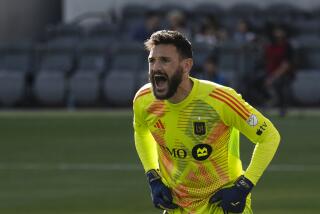Column: Novel approach to youth academy paying dividends for LAFC
- Share via
The idea was confusing at first.
The fledgling Los Angeles Football Club had coaxed Todd Saldaña away from U.S. Soccer to develop the team’s youth academy. Yet just a year into the job, LAFC pointed him to some videotape, handed him a few phone numbers and asked him to scout a first-team player in South America.
He wasn’t alone. Every coach on the academy staff was asked to look at someone the team wanted to sign to its first MLS roster.
“It felt groundbreaking to include the academy staff in the first-team planning,” Saldaña said last week, 10 months after the report he wrote helped LAFC land Uruguayan forward Diego Rossi, the team’s leading scorer with 14 goals.
The idea seemed obvious to John Thorrington, the team’s executive vice president of soccer operations and one of the men who came up with the plan. That wasn’t the only novel thing Thorrington has tried while building an MLS team that is headed for the playoffs and an academy that has won two major trophies in the last four months.
The most prestigious prize came four weeks ago when LAFC’s youth team beat a Mexican opponent to become the first U.S. team to win the CONCACAF Champions League U-13 tournament.
Thorrington had never been an MLS executive before being hired by LAFC, so he wasn’t wedded to doing things a certain way because that’s the way things had always been done. If the academy’s coaches were supposed to take young boys and turn them into LAFC players, maybe it would be helpful if they first scouted the kind of players Thorrington wanted to build around.
It “was incredibly valuable,” Thorrington said, because it “forced them to have conversations about what we’re looking for in the first team.”
What Thorrington saw little value in, however, was having a fully built-out academy from the start as many MLS teams did. Atlanta United, for example, which joined MLS just last season, already has seven youth teams, from U-12 through U-18/19.
LAFC, which opened its academy two years before its MLS team took the field, followed a more deliberate approach, spurning the well-stocked youth teams left behind by Chivas USA — passing on the likes of Efrain Alvarez, Ulysses Llanez and Cesar Rivera, who all wound up with the Galaxy — to build its own program from the ground up.
“The most exciting part of this whole project is that opportunity to start from scratch,” Thorrington said. “But it’s also the most challenging. We were given nothing.”
So the academy launched with a U-12 team and nothing more. When those players graduated to the next level, Saldaña and his staff — which includes coaches from Spain, Italy, Argentina and England — recruited a new U-12 team.
It will take at least two more years before the program is fully functional. But that go-slow approach means when that first class reaches the U-18/19 level, the players will be fluent in the attacking, ball-control style of play first-team manager Bob Bradley preaches.
It’s a style that Saldaña, a South Bay native who played for the L.A. Aztecs in the disbanded North American Soccer League before going on to coach at UCLA, Cal Poly Pomona and Loyola Marymount, also prefers, which is how he got the academy job in the first place.
Keeping the focus on fewer teams and fewer players — LAFC has about 90 in the academy now — has paid off. Top Drawer Soccer ranked LAFC’s U-13 and U-14 teams as the best in the nation last May while six academy players — defenders Armando Avila, Beau Yantz and Tony Leone, midfielder Dylan Presto, forward Christian Torres and winger Kevin Jimenez — spent time in the U.S. youth national team camp this year. Another, goalkeeper Donovan Palomares, trained with Mexico’s youth national team.
“As we were starting, we wanted to take on what we were confident we could do really well,” Thorrington said. “We started with the end in mind. We said, ‘This is what our first team needs to look like.’ The academy staff, what they are professionals at, is what does that mean for a 12-year-old?”
The answer to that question will change over time, so the offices on the second floor of LAFC’s performance center at Cal State L.A. are shared by both the academy and first-team staffs. By design there are few walls and even fewer doors, which Thorrington hopes will lead to more dialogue among the coaches — dialogue that sometimes becomes animated.
“John and Bob don’t expect my staff to be yes men,” Saldaña said. “We have heavy debates about the game.”
Just in case he needs a conversation starter for those debates, Saldaña keeps the trophies from the CONCACAF Champions League and Nexen Manchester City Cup — the first prizes in franchise history — on a shelf near his desk.
“Everybody from ownership on down is very pleased and proud of what’s happened so far,” Thorrington said. “But all of this is about being sustainably competitive.
“Right now our plan is to make sure we’re doing the best with the players that we have in our own local market. We have the most talent-rich market in the country. Let’s start there.”
kevin.baxter@latimes.com | Twitter: @kbaxter11







